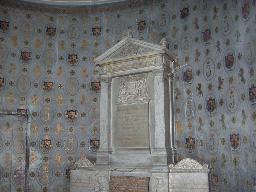James II, king of England |
| MONARCH (ENGLAND) |
|
BORN 14 Oct 1633, London: St. James's Palace - DIED 16 Dec 1701, Saint-Germain-en-Laye, Yvelines CAUSE OF DEATH brain hemorrhage GRAVE LOCATION Saint-Germain-en-Laye, Yvelines: Église St.-Louis ((some of his bowels only, his body was lost)) |
|
James II was the third son of king Charles I and the second to survive. During the Civil War he was confined in St James's Palace, but he escaped in disguise to The Hague. He went to France, where he joined the army. In 1656 he moved on to serve the Spanish army. In 1660 his older brother Charles II came to power after Cromwell died and he went back to England as well. In 1659 he had married Anne Hyde, the daughter of the Earl of Clarendon. He became commander of the Royal Navy and secretly became a Catholic in 1668 or 1669. In 1671 his brother allowed him to marry Maria d'Este, a Catholic princes of Modena. In 1673 he opposed the Test Act, the barred Dissenters and Catholics from important positions. Soon afterwards he gave up his position in the army and left England. Charles II died in 1685 without a legal heir and he became king as James II (and James VII in Scotland). Charles' illegitimate son the Duke of Melmouth declared himself king and was immediately supported by many Protestants. But he was beaten at Sedgmoor and beheaded afterwards in London. By 1688 religious trouble had grown. The situation grew worse after his wife Mary gave birth to a son, dashing Parliament's hopes that his protestant daughter Mary would succeed. After the king forced the Declaration of Indulgence on the Protestants, seven Protestant noblemen asked the prince of Orange to invade England with an army. The prince of Orange came. James II refused the help of Louis XIV, but Protestant many soldiers abandoned him and his daughter Anne left his court. As William landed at Torbay he threw the Great Seal of the Realm into the river Thames and tried to escape to France. He was caught in Kent, but the Prince of Orange allowed him to escape. In 1689 he landed in Ireland with a French army to regain his crown. But on July 1st, 1690 he was defeated by William of Orange at the Battle of the Boyne. Again he fled to France, where Louis XIV gave him a large pension and he was allowed to live at the palace at St. Germain-en-Laye near Paris. After he refused the Polish crown that Louis offered him the latter stopped his political support. He died in 1701 and was buried at the Chapel of Saint Edmund in the English Benedictine Church in the Rue St. Jacques in Paris. During the French Revolution his remains were desecrated and subsequently lost. Some of his bowels were sent to the Église St.-Louis in Saint-Germain-en-Laye and are still there. His brain is kept in an urn in a chapel at Scots College in Paris. |
| Images |



